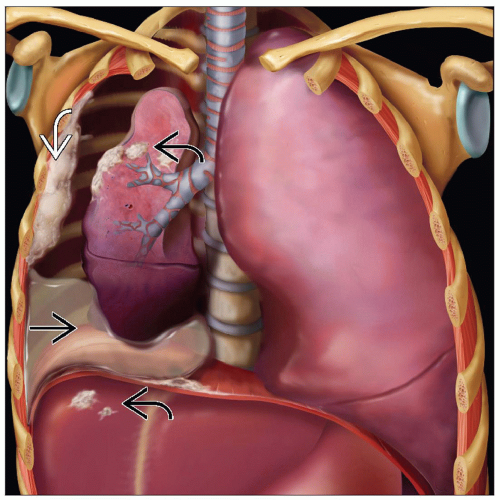Diffuse Large B-cell Lymphoma Associated with Chronic Inflammation
Wei Liu, MD, PhD
L. Jeffrey Medeiros, MD
Key Facts
Terminology
DLBCL-CI is large B-cell neoplasm that occurs in context of longstanding chronic inflammation
Most cases occur in body cavities or narrow spaces
Pyothorax-associated lymphoma (PAL) is most common and prototype
Etiology/Pathogenesis
Chronic pyothorax precedes PAL type of DLBCL-CI
Very long latency period from onset of pyothorax until PAL
Other causes of DLBCL-CI are rare and include
Metallic implants in bones/joints, surgical mesh implant, longstanding hydrocele
Chronic osteomyelitis; splenic false cyst, atrial myxoma
Clinical Issues
Patients with PAL present with
Chest/back pain, tumor/swelling of chest wall
B symptoms, cough, dyspnea, hemoptysis
Other types of DLBCL-CI can present incidentally
Microscopic Pathology
Diffuse large B-cell lymphoma
Centroblastic, immunoblastic, or plasmablastic
Ancillary Tests
Nongerminal center B-cell immunophenotype
EBV(+), HHV8(−)
Top Differential Diagnoses
Primary effusion lymphoma
Systemic lymphomas involving body cavity lining
TERMINOLOGY
Abbreviations
Diffuse large B-cell lymphoma associated with chronic inflammation (DLBCL-CI)
Synonyms
Pyothorax-associated lymphoma (PAL)
PAL is not true synonym but represents > 90% of cases of DLBCL-CI
Definitions
DLBCL-CI is large B-cell neoplasm that occurs in context of longstanding chronic inflammation
Most cases occur in body cavities or narrow spaces
Pyothorax-associated lymphoma (PAL)
Most common form of DLBCL-CI and prototype
Develops in pleural cavity of patients with longstanding pyothorax
ETIOLOGY/PATHOGENESIS
Infectious Agents
Epstein-Barr virus (EBV) is present in most cases of DLBCL-CI reported
EBV(+) in type III latency pattern in most cases
Chronic Inflammation
Chronic pyothorax precedes PAL type of DLBCL-CI in most cases
Very long latency period from onset of pyothorax until PAL
19-67 years; median 43 years
Other causes of DLBCL-CI are rare including
Metallic implants in bones and joints; surgical mesh implant
Chronic osteomyelitis; longstanding hydrocele
False cyst within spleen; atrial myxoma
Causes of pyothorax in patients who develop PAL type of DLBCL-CI
Result of surgical use of artificial pneumothorax to treat pulmonary tuberculosis
Widely performed in Japan, especially from 1930s through 1950s
˜ 15-20% of patients with PAL have no history of artificial pneumothorax
Tuberculous pleuritis is another cause of chronic pyothorax
Possible roles of chronic inflammation in pathogenesis
Generation of reactive oxygen species
“Local immunosuppression”
EBV(+) B cells can secrete various cytokines; e.g., interleukin-10 inhibits T-cell proliferation
Fibrosis surrounding area may limit access by cells involved in immunosurveillance
Autocrine growth
Interleukin-6 is autocrine growth factor that may be involved
Patients with DLBCL-CI also may have systemic immunosuppression
Not obvious clinically in most patients but possibility not excluded
Possible Role of Gender
PAL type of DLBCL-CI is much more common in men
Men have substantially worse prognosis
Unknown if related to hormonal status, environmental factors, patient behavior, or genetic component
Genetic Factors
PAL type of DLBCL-CI appears to arise from post-germinal center B cells, often with crippling Ig gene mutations
EBV may rescue cells from apoptosis (which would be expected physiologically)
CLINICAL ISSUES
Epidemiology
Incidence
Rare
Most cases of PAL type of DLBCL-CI are reported from Japan; rare in Western countries
2% of patients with chronic pyothorax develop PAL in Japan
Non-PAL types of DLBCL-CI are exceptionally rare, mostly case reports
Age
Adults
Median 65-70 years; range 29-88 years
Gender
Marked male predominance
Stay updated, free articles. Join our Telegram channel

Full access? Get Clinical Tree






